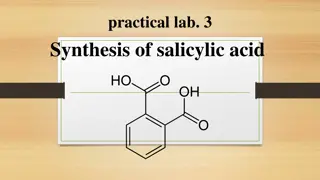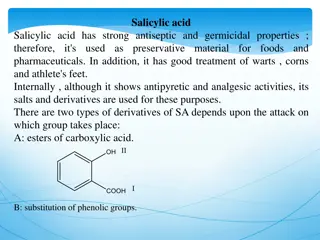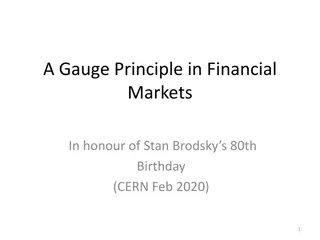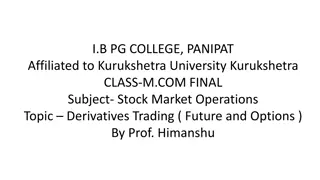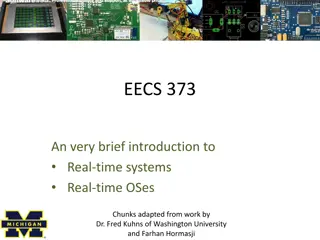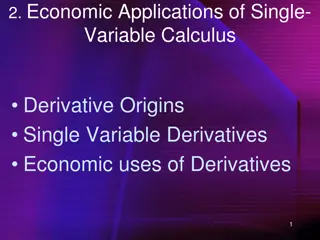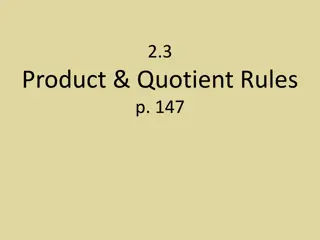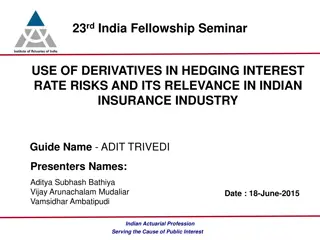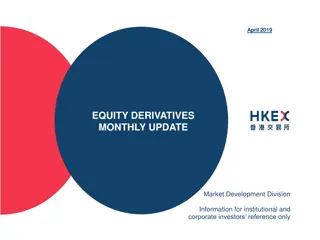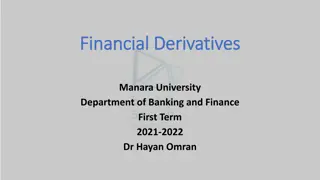Utilizing Derivatives in Real-life Modeling
Differentiation allows us to model various real-life relationships through derivatives. This involves using derivatives to represent rates of change in dynamic situations, such as volume changes in a water tank or an expanding sphere. By differentiating and finding rates of change with respect to variables like time or radius, we can accurately describe how quantities evolve over time. The process of differentiation is exemplified through practical scenarios, showcasing how mathematical concepts can be applied to understand and predict real-world phenomena.
Download Presentation

Please find below an Image/Link to download the presentation.
The content on the website is provided AS IS for your information and personal use only. It may not be sold, licensed, or shared on other websites without obtaining consent from the author.If you encounter any issues during the download, it is possible that the publisher has removed the file from their server.
You are allowed to download the files provided on this website for personal or commercial use, subject to the condition that they are used lawfully. All files are the property of their respective owners.
The content on the website is provided AS IS for your information and personal use only. It may not be sold, licensed, or shared on other websites without obtaining consent from the author.
E N D
Presentation Transcript
Teachings for Teachings for Exercise 12K Exercise 12K
Differentiation You can use derivatives to model many real-life relationships. Remember that you can think of ?? as ????? ? ???? ?? ? ????? ? ???? ?? ? ?? The differential therefore represents the rate of change of ?, with respect to ? It is possible to replace ? and ? with real-life quantities that are changing, in order to model the situation mathematically 12K
Differentiation You can use derivatives to model many real-life relationships. To the right is a water tank, and the volume is constantly changing over time If ? represents the volume of water in litres, and ? represents the time in seconds, then the Volume is a function of time. ? = ?(?) ? = ?(?) If the volume is a function of time, then the differential will represent the rate at which the volume is changing over time.. ?? ??= ? (?) 12K
Differentiation You can use derivatives to model many real-life relationships. ? =4 3??3 Differentiate to find the rate of change of Volume with respect to the radius ?? ??= 4??2 Given that the volume, ? ??3, of an expanding sphere is related to its radius, ? ??, by the formula ? =4 of volume with respect to radius at the instant when the radius is 5cm. Sub in the value of r = 5 3??3, find the rate of change = 4? 52 Calculate = 314 ??3 So at the moment when the radius of the expanding sphere is 5cm, the Volume is increasing at 314cm3 per cm. 12K
Differentiation You can use derivatives to model many real-life relationships. x x y A large tank (shown) is to be made from 54m2 of sheet metal. It has no top. a) Show that the Volume of the tank will be given by: ? = 18? 2 ?? = 2?2+ 3?? The Surface Area is 54 3?3 54 = 2?2+ 3?? Subtract 2x2 With the information you have, you can set up equations for the Volume and Surface Area of the tank 54 2?2= 3?? Divide by 3x 54 2?2 3? ? = ?2? ?? = 2?2+ 3?? = ? We want a formula for the Volume in terms of x only, so we will need to eliminate y This can be done using the SA equation 12K
Differentiation You can use derivatives to model many real-life relationships. ? =54 2?2 x 3? x y A large tank (shown) is to be made from 54m2 of sheet metal. It has no top. a) Show that the Volume of the tank will be given by: ? = 18? 2 ? = ?2? Replace y with the expression above ? = ?254 2?2 3?3 3? Multiply the fraction by x2 With the information you have, you can set up equations for the Volume and Surface Area of the tank 3 ? =54?2 2?4 3? Divide all terms by x ? = ?2? ?? = 2?2+ 3?? ? =54? 2?3 3 We want a formula for the Volume in terms of x only, so we will need to eliminate y Write as 2 separate terms ? = 18? 2 3?3 This can be done using the SA equation 12K
Differentiation You can use derivatives to model many real-life relationships. x x y A large tank (shown) is to be made from 54m2 of sheet metal. It has no top. a) Show that the Volume of the tank will be given by: The Volume will be maximised here (x has to be greater than 0) V ? = ??? ? ??? ? = 18? 2 3?3 b) Find the Maximum volume of the tank So we want to find the value of x for which the Volume is a maximum x The graph to the right shows the equation for the volume The maximum Volume is at the stationary point Differentiate the function and set it equal to 0 Hence, the gradient will equal 0 12K
Differentiation You can use derivatives to model many real-life relationships. x x y A large tank (shown) is to be made from 54m2 of sheet metal. It has no top. a) Show that the Volume of the tank will be given by: ? = 18? 2 3?3 Differentiate ?? ??= 18 2?2 ? = 18? 2 3?3 Set the gradient function equal to 0 b) Find the Maximum volume of the tank 0 = 18 2?2 Add 2x2 Differentiate the function and set it equal to 0 2?2= 18 Divide by 2 So the greatest Volume will occur when x = ?2= 9 3 Square root ? = 3 x must be positive ? = 3 12K
Differentiation You can use derivatives to model many real-life relationships. x x y A large tank (shown) is to be made from 54m2 of sheet metal. It has no top. a) Show that the Volume of the tank will be given by: ? = 18? 2 3?3 Let x = 3 ? = 18? 2 ? = 18(3) 2 3?3 3(3)3 Calculate V b) Find the Maximum volume of the tank ? = 36?3 Differentiate the function and set it equal to 0 So the greatest Volume will occur when x = 3 12K







